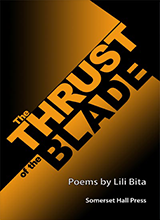Lili Bita – The Thrust of the Blade. Reviewed by Prof. Ekaterini Georgoudaki
(Dr. Ekaterini Georgoudaki is Professor Emerita in the Department of English at the Aristotle University of Thessaloniki.)
The Thrust of the Blade, a collection of 31 poems divided into two parts, deals mainly with sickness, decay, death, violence, pain, loneliness, and unpleasant memories. A characteristic statement made in “Arson”: “the world is a crown / of thorns / the sun is a cannibal,” conveys the prevailing mood in the collection. In this kind of world life starts and ends with the physical body. There is no reference to the spiritual aspect of life, to the existence of a soul, and no hope is expressed for life after physical death.
Bita creates images of bent spines, broken backs, maimed and mutilated bodies, festering boils, faces shattered by gunshots, blood flowing from wounds, etc. to expose the vulnerability and suffering of the physical body. She is particularly sensitive to the oppressive patriarchal customs that deprive women of the joys of life (“Hymen”) and to the violence against women committed by husbands (“And Now the Flies”), through rape (“In Memoriam”), genital mutilation (“The Reaping of the Bud”), and public humiliation (“Shaved”). She also shows her sensitivity to the abuse and exploitation of wild animals that are torn from their natural environment, carried to other countries and forced to become circus actors for the amusement of people and the profit of their enslavers (“The Circus Actors”).
Through such images as coffins, boxes carrying the bones of dead people, graves, epitaphs carved on marble slabs, pits holding human bones in Peru (“Bone Flowers”), cemetery crosses, candles and incense, holy icons on coffins in Greece, an altar at a Tibetan temple where a dead woman’s body is cut into pieces and offered to the vultures (“A Piece of Meat”), Bita gives us a glimpse of different approaches to death and different burial customs existing around the world. In some poems she also stresses the ugliness of physical death by making realistic descriptions of flies, insects (“And Now the Flies”), and vultures feeding on dead bodies.
Several poems are set in Greece. Cypress trees planted in cemeteries, olive trees, acacia trees, various flowers, island coves and harbors, sheep and goats, the Aegean sea, the Attic sun, buildings in Athens are some images from contemporary Greece that mix with images of ancient temples, statues, and artifacts, as well as with references to mythical and historical figures and events in ancient and modern Greece (Medusa, Agamemnon, Nereids, Asia Minor catastrophe in 1922, the dictatorship of the Colonels, 1967-74, and their Yellow House of torture in Athens). Thus Bita manages to convey characteristic aspects of the Greek natural and cultural landscape and to connect the past with the present, myth with everyday life. Moreover, the use of settings in the USA, Africa, Peru, Tibet, China, and other places, in a number of poems, broadens the poet’s scope and universalizes her themes.
Bita’s poetic language in Greek is characterized by powerful images and metaphors. Robert Zaller’s skillful English translation succeeds in conveying
the power of her language. Through translating her poems Zaller enables Bita to reach a new audience within the wider American community and to win the position she deserves in the rich literary landscape of the USA.

